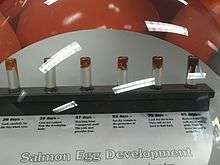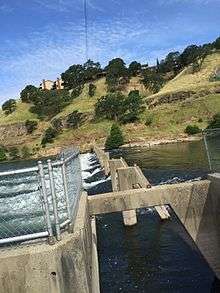Nimbus Fish Hatchery
The Nimbus Fish Hatchery is located in eastern Sacramento County, built on the downstream side of the Nimbus Dam.[1] It is one of the 21 fish hatcheries the California Department of Fish and Wildlife oversees.[2] Chinook salmon and steelhead are raised, and about 4 million Chinook salmon and 430,000 steelhead released each year.[3]
History
Salmon once spawned in the far reaches of California's rivers but with the era of dam building came the loss of spawning ground. Upstream rivers have been damned to control flooding. This has greatly diminished the availability of appropriate habitat for the fish to spawn and live in. Historically, Chinook salmon would migrate annually up the American river to the forks and streams in the Sierra Nevada mountains but Nimbus and Folsom Dams now limit them to the Lower American River. In 1958, Nimbus Hatchery was established to mitigate the impacts the newly constructed Folsom and Nimbus Dams have on Chinook Salmon and Steelhead Trout populations in the American River. [4] Those salmon and steelhead that cannot find a place to spawn in the approximately seven miles of remaining habitat below the dams will climb the fish ladder to Nimbus Hatchery, where they will be artificially spawned and their eggs reared for release back into the river.
Spawning habitat
Salmon return from the ocean to the rivers of their birth in search of specific spawning habitat. They seek out gravel 2-4 inches in diameter with which to construct a series of nests called bedds. During development small salmon need side pools on the river in which to rest in the cool shade and to hide from predators. Thick vegetation along the waters edge provides shade to keep the water cool enough to survive in warmer months. Salmon require 7ppm of oxygen and a pH between 6.5 and 8. Many spawning habitats have been destroyed or are threatened by development, water pollution, water diversions, and erosion and siltation. Because of this the fish hatchery programs have been put in place to sustain fish populations.[5]
Impacts on salmon and steelhead
- Number of fish released annually: Salmon (4 million) Steelhead (430,000)
- Number of fish spawned (average): Salmon (2,600) Steelhead (200)
- Number of eggs taken: Salmon (6 million) Steelhead (1-2 million)
- Average number of eggs per female: Salmon (5,200) Steelhead(5,600)
- Average weight at spawning: Salmon(15-35 lbs) Steelhead(6-10 lbs)
- Record weight: Salmon-138 lbs (Alaska) 107 lbs (California) 62.5 lbs (Nimbus) Steelhead-42 lbs (Alaska) 23 lbs (California) 20 lbs (Nimbus)
- Incubation time: Salmon (45 days) Steelhead (35 days)
- Spawning season: Salmon (Oct.- Dec.) Steelhead (Jan. –Mar.)

Nimbus Hatchery Operation

The hatchery is operated by the California Department of Fish and Wildlife and owned and funded by the Bureau of Reclamation as mitigation for Folsom and Nimbus Dams. Each year 4 million juvenile Chinook salmon and 430,000 steelhead trout are raised in the hatchery and then released to complete their journey down the river.[6]
The hatchery is part of a greater interconnected network within the region. The dams upstream from the hatchery generate power, supply water, and are a main source of flood control.[7] As shown in figure 3, the weirs guide salmon in the direction of the ladder to enter the hatchery. From November through March river water flows down the fish ladder to encourage fish to enter and climb the steps to the hatchery. The gate at the foot of the ladder is closed when the holding pool at the top is full in order to prevent overcrowding. Ripe (ready to spawn) fish are brought from this holding pool into the hatchery spawning deck, where workers collect eggs from the females and milt from the males. Fertilized eggs are placed in hatching jars, with river water upwelling from the bottom to simulate natural conditions. When the eggs are ready to hatch the jars are tipped into large tubs where the baby fish (alevin) will remain while they absorb their yolk sacs and become free-swimming. They are then moved outside to raceway pools where they are feed multiple times a day and grow rapidly. Once the fish are ready to begin their outmigration to the ocean, at 60 fish to the pound for salmon and 4 fish to the pound for steelhead trout, they are loaded into tanker trucks and transported to the river for release. From here they make their way downstream and eventually journey out to sea.[8]
Contributions
Each year the hatchery raises around 4 million baby salmon. Winter runs of steelhead trout produce nearly 430,000 annually. Fish grow to about 4-6 inches in length at the hatchery before being released into the American River.[9] To measure the success of hatchery programs and release points, one quarter of the salmon and all of the steelhead have their adipose fin clipped and a coded wire tag implanted in their nose which contains information on hatchery of origin, age, and release site.[10] Nimbus Fish Hatchery is one of many interconnected Hatcheries in the state of California that are put in place to mitigate impacts on sensitive species. Other Salmon and Steelhead Hatcheries include: Iron Gate Fish Hatchery, Mad River Fish Hatchery, Trinity River Salmon and Steelhead Hatchery, Feather River Fish Hatchery, Warm Springs Fish Hatchery, Silverado Fisheries Base, Merced River Salmon Hatchery, and Mokelune River fish Hatchery.[11]
Goals
The Nimbus Fish Hatchery was established as part of a greater habitat mitigation network. Currently the majority of Chinook fry from the hatchery are released in the American River near the hatchery to encourage thorough imprinting on their home river, which is thought to improve their odds of returning to the correct river as adults and to reduce straying. About one quarter of the fish are trucked further down to the Delta in order to avoid predation from larger fish, such as bass, and other wildlife. The Hatchery is also taking measures to install chillers and UV filtration to ensure acceptable water temperatures for eggs and fry in light of the reduced snow pack and warmer temperatures associated with climate change.[12]
Concerns
The hatchery supplements the natural population but concerns remain regarding its potential effects. One concern is how the hatchery population relates to the natural population. Main concerns focus on competition, predation, effects of behavior, and potential disease. Hatchery fish populations may react to the natural environment differently than naturally spawned fish do. They are coming from a controlled environment in which food was readily available, which affects their size and relative fitness. To better understand the impacts of the hatchery population, research teams are continually studying salmon populations. Hatchery practices are evolving and will continue to evolve as we come to better understand the needs and life history of these fish.
Related links
- California Hatchery Program
- Hatchery Review
- California Salmon Spawning[13]
References
- ↑ "Recreation.gov recreation area details - Nimbus Fish Hatchery - Recreation.gov". www.recreation.gov. Retrieved 2016-03-02.
- ↑ "CDFW Fish Hatcheries". www.wildlife.ca.gov. Retrieved 2016-03-02.
- ↑ California Department of Fish and Wildlife. "Why a Hatchery?". p. 2. Retrieved 2016-03-02.
- ↑ https://www.wildlife.ca.gov/Fishing/Hatcheries/Nimbus/History
- ↑ (PDF) http://www.pac.dfo-mpo.gc.ca/education/documents/sicinter-secinter/sic_intermediate_unithandouts_3.pdf. Missing or empty
|title=(help) - ↑ http://cahatcheryreview.com/wp-content/uploads/2012/08/CA%20Hatchery%20Review%20Report%20Final%207-31-12.pdf#page=83
- ↑ https://www.wildlife.ca.gov/Fishing/Hatcheries/Nimbus/History
- ↑ http://cahatcheryreview.com/wp-content/uploads/2012/08/CA%20Hatchery%20Review%20Report%20Final%207-31-12.pdf#page=82/
- ↑ http://www.visitfolsom.com/history/nimbus_hatchery.aspx>
- ↑ https://www.wildlife.ca.gov/Fishing/Hatcheries/Nimbus/History
- ↑ "California Hatchery Review Report" (PDF). California Hatchery Review. U.S Fish and WildlifeService and Pacific States Marine Fisheries Commission.
- ↑ http://cahatcheryreview.com/wp-content/uploads/2012/08/CA%20Hatchery%20Review%20Report%20Final%207-31-12.pdf#page=82/
- ↑ "California Hatchery Review Report" (PDF). California Hatchery Review. U.S Fish and WildlifeService and Pacific States Marine Fisheries Commission.
Coordinates: 38°38′00″N 121°13′31″W / 38.6333°N 121.2252°W